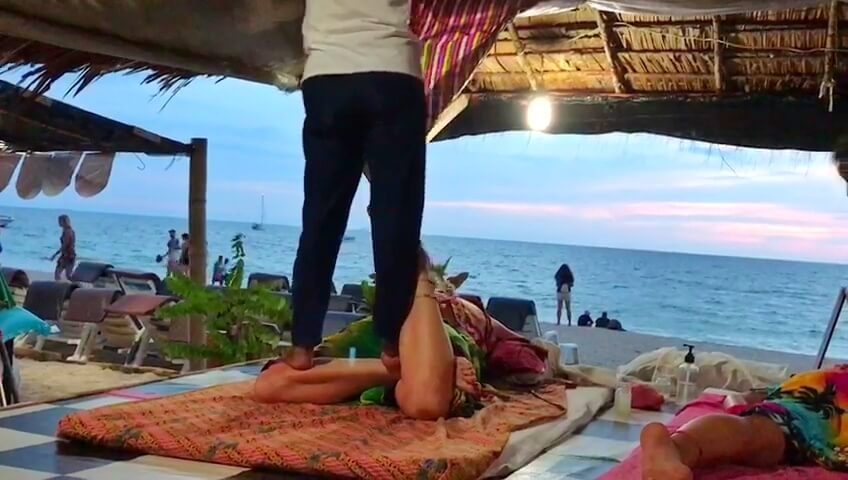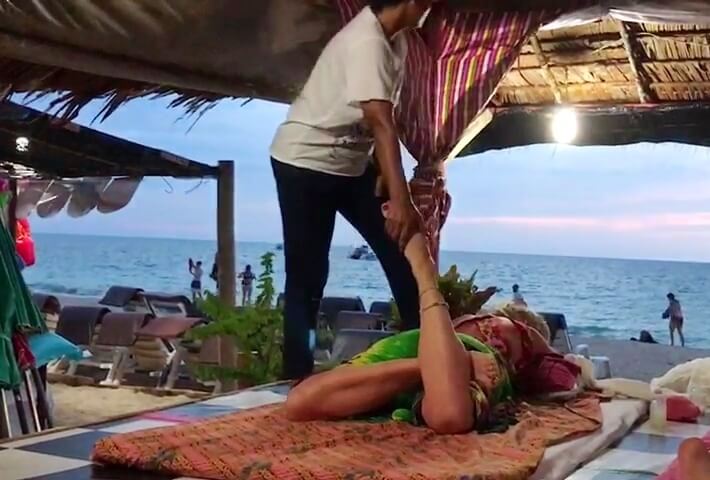In January 2017 I went to Thailand to learn Thai massage in the most traditional and probably the most famous school in the world – Wat Po in Bangkok.
When I received Thai massages myself, whether in Thailand or anywhere in the world, I noticed that they are sometimes quite different to what I learned. So in January 2018 I went to Thailand again. This time for a month and this time with new approach towards learning. I travelled West and South, islands and mainland and I received as many massages as I could in many various locations. Just to experience and compare diversity of techniques. This allowed me to ‘steal” the best moves and incorporate them with the traditional routine I learned in Wat Po 🙂
In London however people seem to be afraid of Thai massage. People think it’s very hard and painful and they will be put in acrobatic positions that are probably very dangerous to the body.
Thai massage doesn’t have to be painful and I believe it’s extremely efficient and beneficial for general flexibility, mobility and wellbeing.
Thais have long recognised that musculoskeletal pain and lack of mobility of the joints is the result of muscles shortening under the under the influence of repetitive strain. Applying pressure to tender muscle can hurt, but there is a difference between that type of discomfort and pain due to excessive or inappropriate pressure and stretching. While it may be difficult to avoid some discomfort when targeting muscle knots, a qualified massage therapist should be able to adjust the massage pressure and movements so that you are not in pain.
So how does it look like?
The main difference is that Thai massage doesn’t use oil. You should be wearing loose and comfortable clothing that will not restrict movements. It is usually performed on a padded mat on the floor and instead of relaxing gliding and kneading motions characteristic of more popular forms of massage, Thai massage employs pressing, stretching and pulling techniques to relieve tension and enhance flexibility and range of motion.
Thais believe that good health and freedom from pain result from undisturbed flow of vital energies through the body’s tissues. The main ‘channels’ for distributing these energies are called ‘Sen’. Pressing is the mechanical process used to stimulate energy flow in the Sen, and to release blockages or stagnation which result in pain. Each Sen channel is pressed repeatedly from every direction. The process is very thorough and takes most part of the massage.
The therapist uses his or her thumbs, palms, forearms, elbows, or even knees and feet and also applies deep muscle compression, joint mobilization, and acupressure.
When the practitioner is satisfied that all soft tissues have been adequately pressed, stretching begins. This will be subtle at first but gradually progresses to the elegant, large scale stretches for which Thai massage is renowned. Every muscle and joint is treated.
Thai massage is not recommended for targeting specific area or muscle only as it treats the whole body.
As the pressure can be variable from medium to hard – it can actually be quite relaxing and it’s even possible to doze off 🙂
Please also be aware that like in every massage, there are some contraindications to Thai massage, for example: injuries, recent operations, fever, osteoporosis, spinal issues.
Written by CityLux Senior therapist Patricia


CityLux Massage therapists Deliver Authentic Thai Massage to Your Home/Hotel/Event within 1hr from 9am till late in Central London. Book Online | Mobile App | Call Now: 020 7602 4196
https://www.cityluxmassage.co.uk






